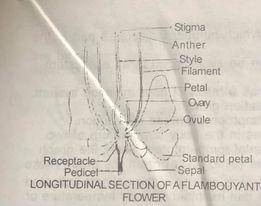You are provided with specimens A, B and C (a) identify specimens A, B and C without reason.
(b) Make a labelled drawing 6-8 cm long of the longitudinal section of specimen A to illustrate its essential features
(c) (i) Suggest the possible means of pollination of specimen A (ii) Give three reasons for your answer
(d) (i) Name one agent of dispersal each for specimen B and C (ii) Give one reason each for your answer.
Explanation

10. (a) Specimen A is an insect-pollinated flower (flambuoyant - flower). SpecimenC is a Tridax fruit with pappus shoot of cocoa and potato blight (a) Culex mosquitoe's larva (b) Breathing (siphon) tube (c) Pupal stage. or in some schools, a cotton seed with lint or with floss.
(c) (i)Specimen A is pollinated by insects (ii) Three reasons for my answer are: (a) Specimen A is brightly coloured (b) Specimen A is scented (c) Specimen A has nectar or nectary (d) It also has mature and sticky stigma (d) (i) Specimen B is dispersed by animals, Specimen Cis dispersed by wind () Reasons for the dispersal of specimen B are: It is brightly coloured. It is also soft, fleshy (succulent) and edible. Specimen C is light enough. It has lint or floss. It has tuft of hairs or pappus to aid buoyance in the air

